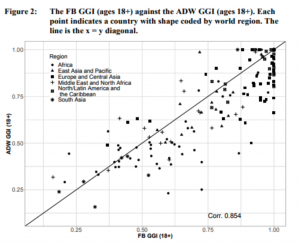
The development of the internet has been plagued by the very same structural inequalities that are prevalent in the real world. The digital landscape had the potential to be a new thriving community that broke down these physical barriers, yet its formation being informed by an inequitable humanity left it victim to several shortfalls. Gender inequality is a curse that crept into the internet. The development of this space has become a force increasing these disparities and whilst women may find new freedoms in accessing the World Wide Web, they remain second class in many cases. Women in developing regions like South Asia have limited access to the internet, pornography has remained a medium poorly representing gender and relationships, and privacy is a major concern for women online. These issues prove that gender inequality is rife on the internet.
Although the internet may seem like a pillar of western culture and commerce, in some other regions the digital landscape is still in its early stages of development. Gender inequality is strongly influencing these stages of rapid growth and creating an internet community fraught with unequal access and sub-par technological education for women. Southeast Asia’s digital economy is projected to be worth more than US$200 billion by 2025, a 400% increase from 2017’s US$50 billion (Anandan, 2018). Such rapid growth can only be found in an industry in its infancy and clearly the internet in the region is in a crucial stage of development.
 By all accounts Gender inequality in Southeast Asia is only being inflamed with this major shift in their economy. Monitoring global digital gender inequality using the online populations of Facebook and Google (Kashya & Fatehkia, 2020) found that “women are significantly underrepresented in the online populations of Google and Facebook in South Asia” and “These platform-specific gender gaps are a strong predictor that women lack internet access and basic digital skills in these populations”. The article’s plotting of the AdWords Gender Gap Index (ADW GGI) against the Facebook gender Gap Index (FB GGI) makes clear the high gender disparity in digital populations in developing nations, South Asia being a prominent example (Figure 2). In a region seeing a digital paradigm shift in its culture and economy gender inequality has increased.
By all accounts Gender inequality in Southeast Asia is only being inflamed with this major shift in their economy. Monitoring global digital gender inequality using the online populations of Facebook and Google (Kashya & Fatehkia, 2020) found that “women are significantly underrepresented in the online populations of Google and Facebook in South Asia” and “These platform-specific gender gaps are a strong predictor that women lack internet access and basic digital skills in these populations”. The article’s plotting of the AdWords Gender Gap Index (ADW GGI) against the Facebook gender Gap Index (FB GGI) makes clear the high gender disparity in digital populations in developing nations, South Asia being a prominent example (Figure 2). In a region seeing a digital paradigm shift in its culture and economy gender inequality has increased.
Women attempting to find a place in an exciting new age for regions like South Asia are faced with centuries old structural barriers. 56.7% of individuals globally are internet users (World Bank, 2019). With such a high participation rate (even greater in 2021), Planet Earth as a whole has a powerful new landscape where South Asian Women are largely absent. Participation on the internet is key to any hope of bettering gender disparities in both developed and developing regions. Therefore, studying the absence of women in populations like that of Facebook and Google makes clear how the Internet’s development has been a defining force for a bleak future for gender inequality.
The conversion of pornography from traditional to digital mediascapes has brought about a rapidly developing cybersex industry and important conversations on gender inequality and degredation. Dangerous Relationships: Pornography, Mysogyny, and Rape (Russell, 1988) argued that the essential features of pornography were more female than male nakedness and the portrayal of men as the dominant sexual partner. This depicts a media burdened with structural gender inequality that burns to the very core of the content. However, the shift of pornographic content to digital mediums has brought about some new features in sexual content whilst maintaining others. Utilising a sample of 45 Internet Adult Outlets Gorman, Turner, and Fish (2010) conducted a content analysis of pornography “in line with Russell’s (1988) work”. Gender Issues (2010) found the sample to (still) have higher representations of dominant men and more women nakedness. With the increased access to pornography, brought about by the aformentioned 56.7% of people globally with immediate access to internet, these same disparities in pronographic representation are a greater problem than ever. The development of the internet has contributed to gender inequality in this manner by allowing more people than ever to view this content that has remained inequitable.
On the other hand, the breakdown of many barriers to entry in the production of sexual content has led to a large increase in pornography produced by women. OnlyFans and other paid amatuer sex work sites allow users to disseminate content without being halted by the capital requirements of traditional medias. Over the past ten years these sites and cam-modelling have become far more prevalent, gradually displacing traditional pornography from the online sex market (Senft 2008). However, this new accessibility for women in the industry has raised questions as to whether it promotes exploitation or empowerment. Bays (2019) “concluded that cam modeling is neither an empowering nor exploitative form of women’s labor; instead, it is marked by uneven levels of agency, subordination, and job satisfaction that can best be understood from the polymorphous perspective. The experiences of cam models are shaped by complex structural conditions and vary across time and place”. Ultimately, the cybersex industry has remained a media landscape fraught with gender inequality regardless of whether it exists traditionally or online. The internet’s development has acted as a catalyst for this content to reach more eyes and therefore be an increasing force in gender inequality.
A new frontier of privacy concern has been brought about by the dawn of the internet and gender inequality plays a key role in the disparity between genders operating in the online landscape. Whilst gender has been found to have no effect on the extent to which data is released, men and women do differ substantially on the level of privacy protection enacted. Women are far more likely to employ security measures to protect their online privacy than men (Park, 2015). This is a negative continuation of gender disparity that exists in the real world as with the development of the internet, this structural inequality has rolled over into the digital landscape. “Our study suggests that gender may affect subjective well-being of online privacy and potentially exacerbate the disparity rooted in socialization of gender. Implications of the findings are discussed in light of Internet access, skill and effort required for building and maintaining privacy” (Et al, 2015). This is a continuation of real world issues as women are twice as likely to be a victim of a violent sexual crime (Australian Bureau of Statistics, 2021). Privacy also continues to be an issue in terms of access to emerging and established technologies for women in developing nations. The video below explores the benefits of equal access to technology in Uganda (Plan International, 2019). The development of the internet had the potential to allow gender to become a meaningless differentiator in terms of privacy and security, but throughout its formation the very same disparity has occurred.
Gender disparity is a structural inequality of the internet that remains a strong part of culture online. With women in developing regions having their access limited to the internet, they are largely left to experience a digital absence when compared to men in the same places. Women in pornography are poorly represented and degradation is a strong theme of this content online. Whilst this is a media not viewed by all, it is an important piece of online culture informing much of what goes on digitally. The development of the internet has been a force increasing gender inequality in this sector as the levels of disparity have remained largely unchanged since Rusell’s 1988 analysis of pornography. Finally, online privacy is vastly more important to women than men indicating a strong distrust and lack of safety felt online. This is a continuation of another real world oppression for women and once again makes clear the internet as an aggressor in gender disparity.
Reference List
ABS. (2021). Crime and Justice Personal Safety in Australia Latest Release. Available at: https://www.abs.gov.au/statistics/people/crime-and-justice/personal-safety-australia/latest-release. [Retrieved 15 October 2021]
Anandan, R., Sipahimalani, R., Saini, S., Aryasomayajula, S., & Smittinet, W. (2018). e-Conomy SEA 2018 Southeast Asia’s internet economy hits an inflection point. Diambil dari Think with Google APAC website: https://www. thinkwithgoogle. com/intl/en-apac/tools-resources/research-studies/e-conomy-sea-2018-southeast-asias-internet-economy-hits-inflection-point.
Gorman, S., Monk-Turner, E., & Fish, J. N. (2010). Free adult Internet web sites: How prevalent are degrading acts?. Gender Issues, 27(3), 131-145.
Kashyap, R., Fatehkia, M., Tamime, R. A., & Weber, I. (2020). Monitoring global digital gender inequality using the online populations of Facebook and Google. Demographic Research, 43, 779-816.
Park, Y. J. (2015). Do men and women differ in privacy? Gendered privacy and (in) equality in the Internet. Computers in Human Behavior, 50, 252-258
Pixabay (2021). Women using Computers in Afghanistan Pixabay. Available at: https://pixabay.com/photos/afghanistan-women-on-internet-79491/ [Accessed 16 October 2021]
Plan International (2019) Girls need technology because… Plan International. Available at: https://www.youtube.com/watch?v=UnhyRShJ2sA Accessed [16 October 2021]
Russell, D. E. (1998). Dangerous relationships: Pornography, misogyny and rape. Sage.
Senft, T. M. (2008). Camgirls: Celebrity and community in the age of social networks (Vol. 4). Peter Lang.
World Bank. (2019) Individuals using the Internet (% of population). World Bank Statistics Available at: https://data.worldbank.org/indicator/IT.NET.USER.ZS [Accessed 14 October 2021]


